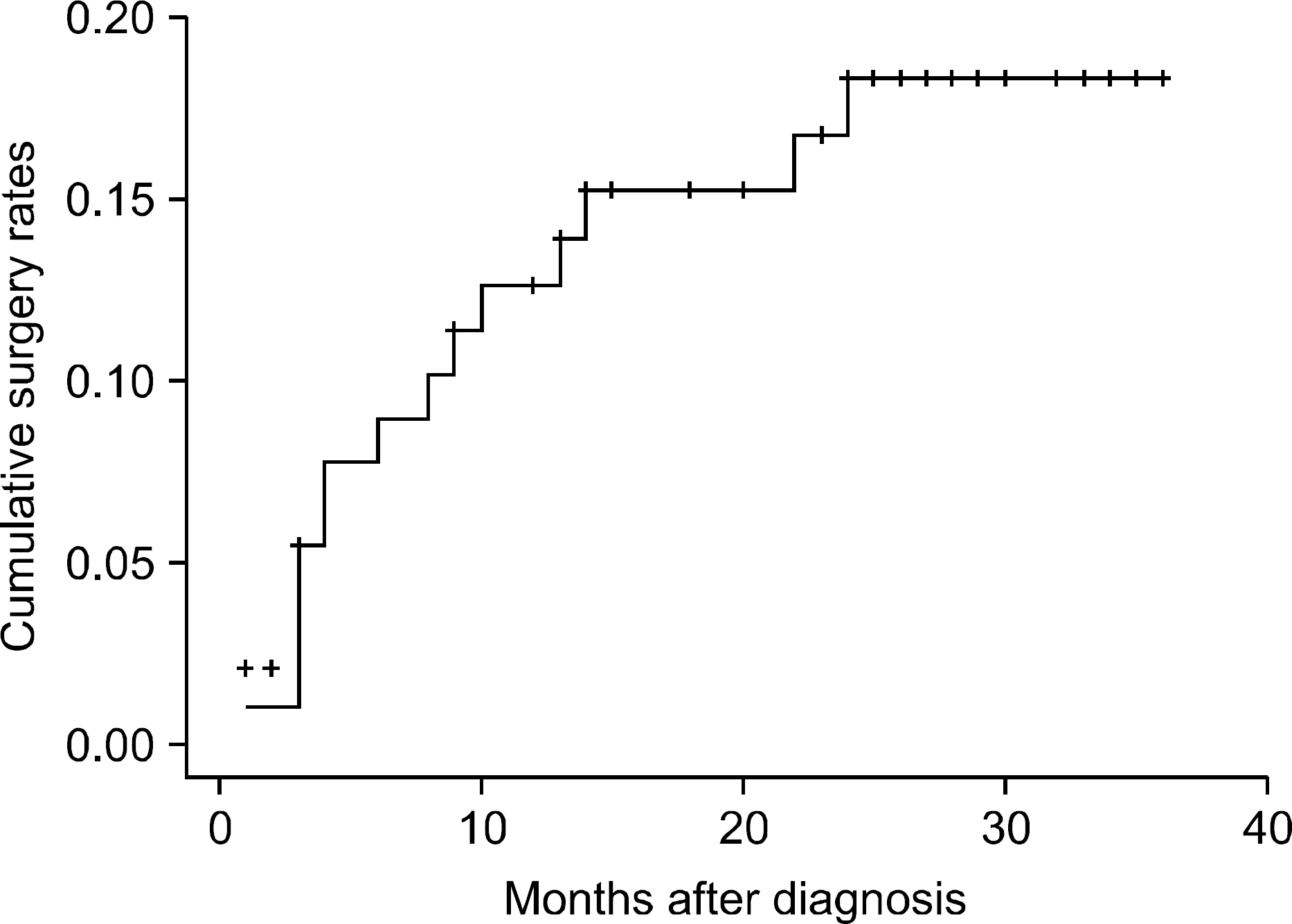Korean J Gastroenterol.
2010 Oct;56(4):236-241. 10.4166/kjg.2010.56.4.236.
Rates of Early Surgery and Associated Risk Factors in Crohn's Disease
- Affiliations
-
- 1Department of Gastroenterology, Ajou University School of Medicine, Suwon, Korea. kjleemd@hotmail.com
- KMID: 1718359
- DOI: http://doi.org/10.4166/kjg.2010.56.4.236
Abstract
- BACKGROUND/AIMS
The individual course of Crohn's disease is diverse, and some patients may require bowel resection. The aims of this study were to determine the early surgery rate of Crohn's disease and to identify risk factors associated with early surgery in Korea.
METHODS
Ninety six patients with Crohn's disease (68 men; median age at the time of diagnosis: 25 years), who had been followed up more than a year, were retrospectively analyzed. Early surgery was defined as a bowel operation for Crohn's disease or its complications occurring within 3 years from diagnosis. Early surgery rate and risk factors for early surgery were identified.
RESULTS
Fifteen patients (15.6%) underwent early surgery. The cumulative surgery rate was 8.6% after 6 months, 11.9% after 12 months, 14.1% after 18 months, and 16.7% after 24 to 36 months. Multivariate analysis revealed penetrating or stricturing behavior to be an independent risk factor for early surgery (p<0.001, Exp (B)=2.97 CI 1.39-6.37).
CONCLUSIONS
The cumulative early surgery rate in Korean patients seems to be lower than Western patients. Penetrating or stricturing behavior is significantly associated with early surgery, requiring early aggressive medical treatments.
Keyword
MeSH Terms
Figure
Reference
-
1. Shivananda S, Lennard-Jones J, Logan R, et al. Incidence of inflammatory bowel disease across Europe: is there a difference between north and south? Results of the European Collaborative Study on Inflammatory Bowel Disease (EC-IBD). Gut. 1996; 39:690–697.
Article2. Mekhjian HS, Switz DM, Melnyk CS, Rankin GB, Brooks RK. Clinical features and natural history of Crohn's disease. Gastroenterology. 1979; 77:898–906.
Article3. Binder V, Hendriksen C, Kreiner S. Prognosis in Crohn's disease–based on results from a regional patient group from country of Copenhagen. Gut. 1985; 26:146–150.4. Elliott PR, Ritchie JK, Lennard-Jones JE. Prognosis of colonic Crohn's disease. Br Med J(Clin Res Ed). 1985; 291:178.
Article5. Basilisco G, Campanini M, Cesana B, Ranzi T, Bianchi P. Risk factors for first operation in Crohn's disease. Am J Gastroenterol. 1989; 84:749–752.6. Henriksen M, Jahnsen J, Lygren I, et al. Clinical course in Crohn's disease: results of a five-year population-based follow-up study (the IBSEN study). Scand J Gastroenterol. 2007; 42:602–610.
Article7. Gasche C, Scholmerich J, Brynskov J, et al. A simple classification of Crohn's disease: report of the Working Party for the World Congresses of Gastroenterology, Vienna 1998. Inflamm Bowel Dis. 2000; 6:8–15.
Article8. Yang SK, Yun SC, Kim JH, et al. Epidemiology of inflammatory bowel disease in the Songpa-Kangdong district, Seoul, Korea, 1986-2005: a KASID study. Inflamm Bowel Dis. 2008; 14:542–549.
Article9. Park WK, Kim HS, Park JB, et al. Current trend of inflammatory bowel disease. J Korean Soc Coloproctol. 2002; 18:152–155.10. Park JB, Yang SK, Myung SJ, et al. Clinical characteristics at diagnosis and course of Korean patients with Crohn's disease. Korean J Gastroenterol. 2004; 43:8–17.11. Chung KM, Kim HS, Park SY, et al. The changes in incidence of Crohn's disease and intestinal tuberculosis in Korea. Korean J Gastroenterol. 2008; 52:351–358.12. Yoshida Y, Murata T. Inflammatory bowel disease in Japan: studies of epidemiology and etiopathogenesis. Med Clin North Am. 1990; 74:67–90.
Article13. Ekbom A, Helmick C, Zack M, Adami HO. The epidemiology of inflammatory bowel disease: a large, population-based study in Sweden. Gastroenterology. 1991; 100:350–358.
Article14. Gollop JH, Phillips SF, Melton LJ 3rd, Zinsmeister AR. Epidemiologic aspects of Crohn's disease: a population based study in Olmsted County, Minnesota, 1943-1982. Gut. 1988; 29:49–56.
Article15. Sands BE, Arsenault JE, Rosen MJ, et al. Risk of early surgery for Crohn's disease: implications for early treatment strategies. Am J Gastroenterol. 2003; 98:2712–2718.16. Bernell O, Lapidus A, Hellers G. Risk factors for surgery and postoperative recurrence in Crohn's disease. Ann Surg. 2000; 231:38–45.
Article17. Kim CG, Kim JW, Kim HD, et al. Clinical features of Crohn's disease in Korea. Korean J Gastroenterol. 2002; 40:173–180.
- Full Text Links
- Actions
-
Cited
- CITED
-
- Close
- Share
- Similar articles
-
- Risk Factors for Repeat Abdominal Surgery in Patients with Crohn's Disease
- New Aspects of surgical therapy of recurrent Crohn's disease
- Risk of Repeat Surgery for Perianal Crohn Disease
- Early Biologic Treatment in Pediatric Crohn's Disease: Catching the Therapeutic Window of Opportunity in Early Disease by Treat-to-Target
- Risk factors for complications after bowel surgery in Korean patients with Crohn's disease



